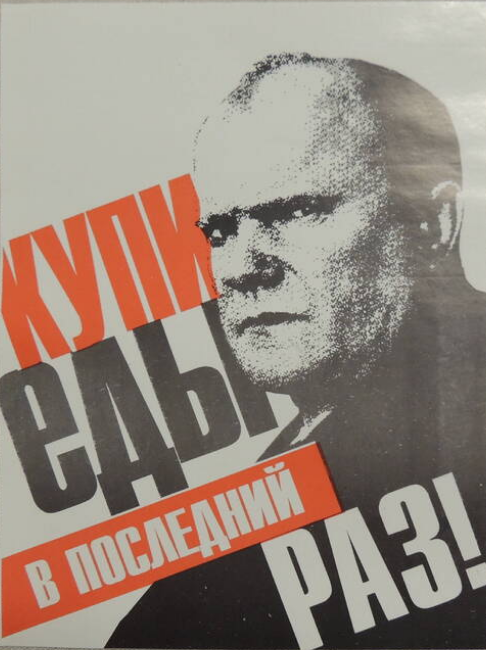Filed Under: Print > Political advertising > “Go buy some food… for the last time!”
“Go buy some food… for the last time!”

After 1991, market forces drove Russian media, politics, and the public sphere closer together than ever before. Initially, newspapers, television stations, and radio broadcasters managed to elude both state and private influence. Soon, however, the neoliberal economic reforms undertaken by Anatoly Chubais (“voucher privatization”) and Yegor Gaidar (“shock therapy”) pushed many media outlets to bankruptcy, toward alliances with the government, or into the arms of newly minted oligarchs enriched in privatization blitzes. By the mid-1990s, most major mass media companies were held by billionaires, the state, or some combination of the two, a consolidation that underpinned Yeltsin’s victory in the 1996 presidential campaign. By 1995, Yeltsin had lost his perestroika-era verve and seemed genuinely vulnerable to challenger Gennady Zyuganov of the resurgent Communist Party. Fearing the prospect of a Communist government, several Russian oligarchs united with consultants from Bill Clinton’s 1992 campaign team to launch a highly successful media offensive against Zyuganov. The main thrust of the offensive was that, should Zyuganov be elected, the country would return to endless queueing, consumer-goods shortages, and empty grocery shelves so many Russians still remembered from the late Brezhnev era. This poster, in which a scowling Zyuganov seems to enjoin voters to “Go buy some food… for the last time!”, is typical of the tactics Yeltsin’s campaign used to discredit the candidate, who would ultimately take a narrow second place in the first electoral round, only to lose to Yeltsin in the second.